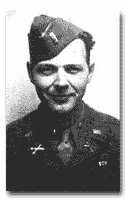
John "Jack" M. Roberts:
Survival in the Battle of the Bulge
On a
cold and snowing Saturday, 9 December 1944, the 592nd Field Artillery
Battalion (FAB), of the 106th Infantry Division, began their move into
the positions of the departing 2d Infantry Division. Battery C of the
592nd (C/592), consisting of four medium 155mm howitzers, would not move
out until the next morning to relieve the 12th FA battalion. The location
was near Saint Vith, an important rail and road center located in Belgium
and due west in the direct vicinity of the German border. It lay southeast
of Liege and of approximately equal distance northeast of Bastogne.
As they rode across France on their way to the front, the men of the green
592nd FAB knew they would eventually receive their baptism of fire, testing
their training for survival. This realization was a progressive process,
that weighed heavily on everyones mind. Certain events, such as being
issued live ammunition, made the prospect of combat more and more real.
This had a somber effect on all the men as the time grew near. The initial
issue was five magazines, with each carrying twelve rounds. The men were
instructed to place one magazine in their M1 carbines, and the remaining
in their ammo belts. Emphasis was placed on the fact that the weapons
were to stay on safe, and no rounds were to be chambered before they entered
the combat zone! The morale for the 592nd FAB was low. One reason was
the cold weather, a mix of sleeting rain and snow. On his way to the front,
John "Jack" M. Roberts, a Corporal with C/592 recalls, "When I ate the
food from my mess kit ... I did as most of the guys did, I just stood
up and ate it as fast as I could while it was still halfway warm." Trying
to shield his food from the rain, "I hunched my body over the mess kit.
Even so, the cold water dripped off my helmet and into my food."
Talk among the men was slight, to say the least. Everyone was thinking
about what was in store for them, trying to image what the situation would
be like if they would have to kill someone. Would they survive the war,
or maybe freeze up in the heat of battle? Roberts explains,
As I looked into the somber faces of my fellow soldiers, each guy was staring into space and appeared to be in deep thought. The odd part of this whole episode, none of us wanted to openly talk about it. Periodically, one of the guys would try to say something funny and the rest of us forced a laugh.
At night
the situation got worse, especially when the temperatures plummeted. When
C/592 went into bivouac on their way to the front lines, the men did not
take the time to set up their tents, or even dig fox holes. They slept
sitting up in the back of their tarpaulin-covered one and a quarter ton
truck, where the tail gate end was open to the elements. Wearing long-johns,
a wool uniform, two pairs of wool socks, combat boots, an overcoat, wool
gloves, and a wool stocking cap under their helmets, it was impossible
to get warm. En route, thoughts of personal survival, loved ones, family,
job, and friends whirled through the minds of every soldier as they sped
through the cold and treacherous Belgian weather. Sitting shoulder to
shoulder, their feet were like blocks of ice and numb.
The area where C/592 would call home was a part of the dense Ardennes
forest that consisted of evergreen and fir trees. The wind which had shaken
most of the white snow coverings off the trees revealed sinister grey-black
trees that seemed to intensify an already eerie atmosphere. By 1800 hours
on the evening 10 December, under blackout conditions, all the batteries
of the 592nd were in position along the German and Belgian border.
The
106th Infantry Division, of which the 592nd was a general support battalion
of the divisional artillery, was situated astride the old German defensive
belt. Known to the Allies as the "Siegfried Line," it was originally intended
to stop the French at the beginning of the war in 1940. The area north
of the Schnee-Eifel and northeast of St. Vith was a mountainous ridge
line and commonly referred to as the Losheim Gap. The gap was considered
as the storm door to the west; a 7-mile wide corridor that led from
Belgium into Germany. The 14th Cavalry Group (XVIII Airborne Corps) held
5 miles of the Losheim Gap with approximately 900 men but without foxholes
or tanks. Tying in with the 14th Cav along a boundary that ran from the
village of Kobscheid and back west to Auw were the positions of the 106th
Division's 422nd Infantry Regiment. The 106th was also spread thin, over
a twenty mile front, so that the remaining two miles of the Losheim Gap
were almost desolate. Along the northern edges of Laudesfeld, a village
just one mile southwest of Auw and approximately four miles to the German
border, C/592 battery sat in a ravine among several farm houses and barns.
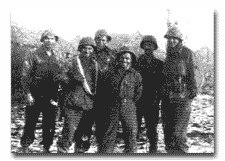
The misery caused by dampness and cold was a reality of winter warfare and unescapable. Trench foot was the norm among the troops that claimed many casualties. Roberts was one of the men who contracted this cold weather injury and has wrestled with it ever since. In Laudesfeld, Roberts and the men of his detail took residency in one of the farm houses along with the radio sections. On the second floor they found some beds without linen where they slept. On the first floor there was a small kitchen, empty of furniture, but with a wood burning stove. Everyone in the Detail Section took their turn on guard duty that included tending to the fire. Meals were served at normal hours from the battery kitchen. Everyone ate in shifts to avoid congregating, just in case of an enemy artillery attack. The food, as usual, was cold by the time the men returned to their firing positions.

The gun crews set about checking their weapons and ensuring they were
combat ready. Forward Observer (FO) teams were comprised of members from
the gun, wire, and radio details that rotated in and out from the FO's
position in the village of Roth; right on the front line and about three
miles from Laudesfeld. Roberts and his FO group were happy to hear that
they were in a quiet sector, given the fact that sporadic small arms and
artillery fire was frequently heard. All in all, however, it was nothing
to get excited about. On 15 December, Roberts learned that the next morning
he would be going forward to the observation post in Roth. To his satisfaction,
he did not have to stand guard that night, so that he could get plenty
of rest for the next day. At 0530, on the morning of 16 December, Roberts
was suddenly awakened by a near by and deafening artillery explosion.
Running downstairs to find out what was going on, he found himself and
the battery under a massive artillery attack!
The larger German counteroffensive, code named Wacht am Rhein, was designed to sever the Allied lines of communication by concentrating three armies along a 85-mile front, crossing the Meuse River between Liege and Namur, bypassing the capital city of Brussels, and recapturing the important logistical port of Antwerp. Here, in the picturesque winter countryside, blanketed by white snow and covered by a gray sky canopy, the German positions in the north had placed the 18th Volksgrenadier Division (VGD) almost directly east of St. Vith that was moving along the Auw-Schoenberg-St. Vith road. Behind the 18th VGD, the Fuehrer Begleit Brigade, a detachment of the elite Army Panzergrenadier Division Gross Deutschland, was moving west while holding the right flank of the 18th VGD. The German attack would roll right over the path of C/592, while aid for the beleaguered defenders of St. Vith would not arrive soon enough.
The German attack of numerous artillery calibers came amidst red, green, and white flares that flickered through the early morning darkness. Roberts remembers how, "The sudden impact of shelling was a thing to fill the heart with terror. In the forests, tree bursts showered branches and splinters and sent trunks crashing into the snow." About an hour later, the artillery stopped and all became quiet. It was an eerie quiet, and amazingly, Roberts and the others were served breakfast by 0700. By 0800, he and his FO group had jumped into their two vehicles, along with their bedrolls, K-rations, and carbines, and headed for Roth. Roberts recalls, "I had a gut feeling that morning that all was not quite right, but I could not tell myself why."
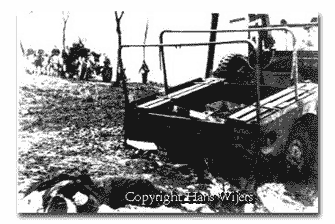
The first vehicle, a 1/4 ton jeep, carried Roberts who sat in the back.
The Forward Observer (FO), Lieutenant Rex C. Matson, was in the front,
and the driver was Private First Class Larry Loudon. The vehicle that
followed, a 3/4 ton Dodge weapons carrier with a caliber .50 machine gun,
carried eight men who were mostly radio and wire personnel. Arriving at
G-2, the Divisional Artillery HQ, Lt. Matson was told to continue on to
Roth. He was also told that the shelling from earlier this morning was
not out of the ordinary but routine. The two vehicles drove on, traveling
on a southern road that took them through friendly positions and into
Auw. Passing through Auw, they continued on a snow covered, barely double
lane road. Many of the trees had been shattered and uprooted from the
earlier artillery barrages. Huge black impact craters could be seen scattered
throughout the fields as they traveled over a slight rise. Rounding a
bend in the road, they entered a clearing where they were greeted by a
sudden explosion of small arms fire. They had run straight into a German
ambush! Criss-crossing machine guns, automatic pistols (the MP-40, also
known as "burp guns" for the noise they made that sounded like someone
burped), and rifle fire banged against their vehicles as bullets whizzed
by the men as both vehicles came to a skidding halt. "Our jeep driver,
Larry Loudon," Roberts remembers, "who was sitting directly in front of
me, was immediately hit in the right shoulder. The machine gun operator
in the weapons carrier to our rear was shot in the forehead before he
could fire the first round, and a Wireman in the back of the truck was
hit as well." He adds, "Before the jeep came to a halt, I jumped from
the rear seat into a ditch on the left side of the road. I think I hit
the road with only one foot before making a dive head first into a snow
bank."
The other men took cover on the opposite side of the road. Many were hit as Roberts could hear them yelling in agony. Sensing that his location offered better cover, he yelled to the others to cross over to his side of the road. Noticing movement along the edge of the tree line, he fired at the Germans who were well camouflaged wearing white snow suits. "Anything in the distance that moved, "he recalls, "I shot at. Whether I hit anyone or anything I do not known." One at a time, Lt. Matson and the other men, some of whom had already been wounded, darted across the road to join Roberts. Unfortunately, the last man to cross, Corporal Scudder, was hit in the leg. As the murderous cross-fire continued, Roberts explains,
I could hear the groaning of our wounded and when I turned to look at them I could see the painful expression in their faces. I could also see the windshield was shattered in the weapons carrier and hear the vehicle's tires being blown out. The jeep I was riding in continued to roll after we jumped out and overturned in a ditch.
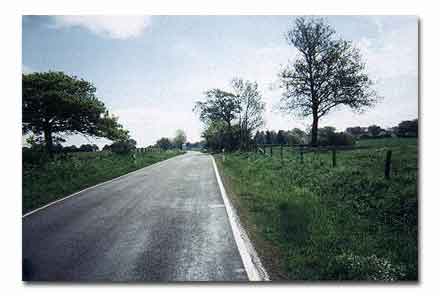
Despite the objection of others, Lt. Matson jumped up and ran for the
machine gun on the weapons carrier. A hail of bullets showered the Lieutenant
as the earth lifted up around him, taking a hit to his left arm. He came
tumbling back into the ditch groaning in pain. Of the nine men still alive,
seven were wounded. Only Roberts and Sgt. Harry Hallberg were still intact.
After a quick conference about what they should do, and given the hopelessness
of the situation, they all decided to give themselves up. At this point,
according to Roberts, Lt. Matson ordered him to surrender. Roberts remembers
reaching into his pocket and pulling out a white handkerchief. He remembers,
"I tied the handkerchief to the tip of the barrel of my carbine and began
to wave it. The firing stopped and about twenty screaming Germans in white
camouflage suits came rushing toward us carrying either automatic pistols
or rifles that were painted white. From the way the Germans acted, it
seemed they could taste victory."
Only the men that could still raise their arms lifted them to surrender. Quickly, the German soldiers confiscated their weapons and took everything out of their pockets, which included the Waltham wrist watch that Roberts was wearing. He received it from his grandmother as a high school graduation present. Not able to understand what they were saying, the Germans kept screaming at them.
Then, as the fog began to lift, numerous German tanks, armored vehicles, and artillery emerged from the tree line. The sight and noise of squeaking tank tracks and engines was "god awful and deafening." After being marched through the forest and into a clearing, Roberts realized that they were in the middle a German command post. "I saw a mass of German soldiers, officers and equipment. There were tanks, antitank vehicles, machine guns, cannon, and other odd looking vehicles." With German officers barking orders and looking at maps that were laid out on tables and hanging from trees, the German artillery continued to fire from an assortment of weapons. He remembers vividly how, "The stench of fuel, engine exhausts, gun powder, and the loud noise of motors, confined within the forest, was frightening. I made up my mind that the first chance I had to get the hell out of that situation, I would do it."
.gif)
The reality was that Roberts and his men had been overrun by the German
294th Regiment, of the 18th VGD. The objective for the 18th VGD was St.
Vith, and during their approach to it, they handed the US Army one of
their worst defeats in history. Two regiments of the 106th Infantry Division,
the 422nd and 423rd, were surrounded and captured. Roberts and his buddies
were then handed over to two other Germans, presumably guards, who were
dressed in regular uniforms. They nudged them with their burp guns and
gave some German command to begin walking, thereby leading them off, behind
the lines, into the heart of Germany. It looked as if the war was over
for Roberts and his fellow soldiers.
Not knowing where the German guards were taking them, they continued through the deep snow, carrying their wounded. Roberts remembers how he frantically began trying to answer his own questions about what was in store for him. He was afraid of what they were told back home, that the Germans were not nice to American prisoners. After trying to negotiate over an ice pond while carrying his buddy, Larry Loundon, Roberts fell through the ice and got ice cold water in his boots, so that the trek into the unknown had taken another turn for the worse. Soon there after, the group came upon the small village of Wecherath.
Still at a considerable distance, Roberts could see several farm houses and barns. As they entered the village, luck seemed to be on their side as a passing American tank and a GI on foot scared off the two Germans. In the village they met a Captain from Troop C of the 14th Cav who explained his situation. They were surrounded, and the Germans were pressing against the village from all sides. With twilight hours fast approaching, the Captain decided it was time to make a run for the next village. He gave Roberts four hand grenades, Sgt. Hallberg a cal. 45 pistol, and a rifle to PFC Terrill Rigdon. They all planned to escape in two waves, allowing those who needed medical attention to escape in the first wave led by a tank. The objective was to reach Manderfeld. After a hair-raising dash across an open field, while under constant German small arms fire, they reached the village without incident. Once Roberts got out of the truck, he looked to see how the truck had faired during the get-away, and he recalls, " ... the number of bullet holes in it made it look like Swiss cheese."
Manderfeld was a repeat of Weckerath. They were surrounded again and had to make an escape to the west. The group had dwindled to three men after the wounded had been taken separately out of Weckerath. After asking a Cavalry officer for a compass, Roberts and his three buddies slipped out into the cold night and left Manderfeld. Cold, hungry, and nervous, they moved west along tree lines, hedge rows, and low lying areas and fields. Roberts recalls,
I do not know how far we had traveled that night but progress was slow and we kept heading west. This entire day, 16 December, had to be the worst day of my entire life, but also was the most fortunate day of my entire life. In less than 24 hours, we were ambushed, shot at, captured, taken prisoner, escaped, shelled, surrounded, shelled, escaped, shot at, surrounded again, escaped again, cold, wet, hungry, tired, and nervous ... but also alive, and most thankful to God for that!
After dawn broke on 17 December, Roberts and his two buddies found an abandoned barn in Eimerscheid where they recuperated and planned their next move. Deprived of sleep and food, the men were not sleepy or hungry. "It is amazing as to what nerves can do for the body," Roberts recalls. "In fact, we were hungry, but food did not even sound good at that moment. All we wanted to do was get the hell out of there and get back to our outfit."
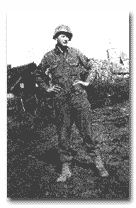
It took the three men over an estimated twenty-five miles of walking,
spread over five days, to find C battery of the 592nd. Once they did,
they were delighted. The first person they saw was their battery commander,
Captain Robert W. Smith, who "grinned from ear to ear." Capt. Smith was
full of compliments after they told their story. Having heard about the
ambush, he thought they were either killed or captured. Based on his knowledge
for fire direction, and due to a lack of officer personnel as a result
of the fighting, Roberts was promoted to Staff Sergeant on 29 December.
On 9 June 1945, Roberts received a battlefield commission to 2nd Lieutenant,
and in May of the following year he was promoted to 1st Lieutenant.
As he looks back now, Roberts is sure that finding his way back to the American lines in one piece can be attributed to the " ... help from the good Lord who gave us the ability to remain reasonably calm, use rationality, and remember our training which helped us use good sense to make the proper decisions on what to do and where to go." He is also quick to add that "We took no unnecessary chances and we certainly did not try to be heroes. We just wanted to get back alive!" The extreme situations that John "Jack" M. Roberts and his buddies endured is only one example of what many other men endured in their own battle for survival. In all the battles, their cause was a common one; to get back home.